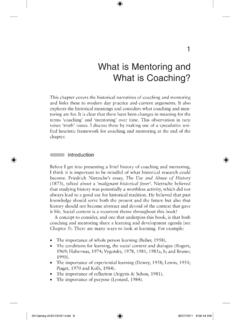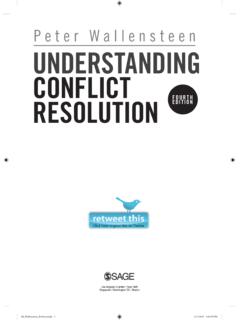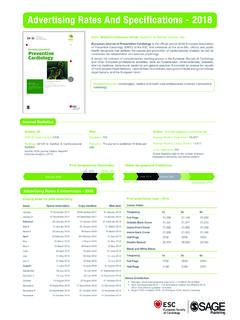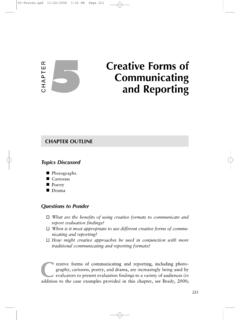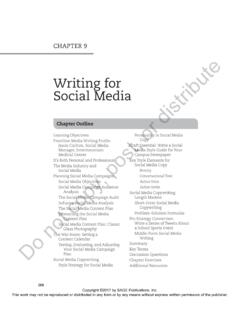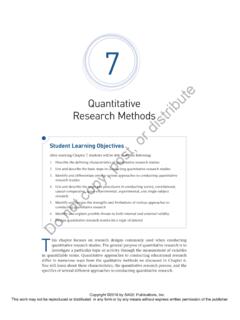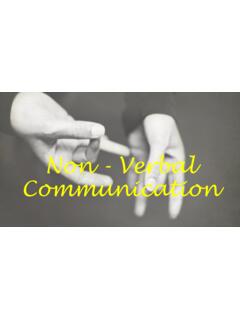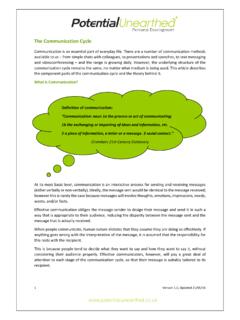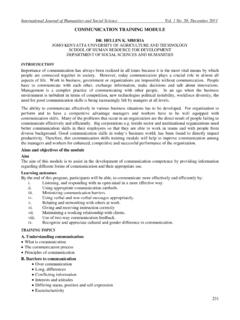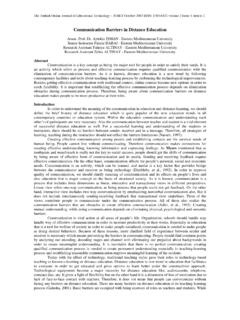Transcription of rvlsoft/Shutterstock.com 2 Verbal and Nonverbal …
1 2 Verbal and Nonverbal not copy, post or distributeCopyright 2020 by SAGE Publications, Inc. This work may not be reproduced or distributed in any form or by any means without express written permission of the publisher. CHAPTER 2 Verbal and Nonverbal communication 21 Verbal and Nonverbal communication have increasingly taken place in a digital environment. the use of emojis has become more and more popular on social media, such as Facebook. today, you will look at emojis, memes, and GiFs and try to deduce if they are worth being a part of your social media marketing efforts as well as teach you a thing or two that will help you use these graphics without embarrassing yourself. We have seen a significant rise in their usage for marketing purposes only in the last couple of years. the main reason for that is actually quite simple; brands and businesses noticed that emojis are a great way to connect and engage with millennials.
2 Additionally, these graphics are a form of visual content, and social media craves visual content (Supan, 2017). As you read this chapter, remember to reflect on how the internet and social media have altered the way you communicate both verbally and nonverbally in the social and professional COMMUNICATIONWhat is Verbal communication ? Verbal communication encompasses both our words and our Verbal fillers ( , um, like). Verbal messages are created through language. Effective communication involves accurate interpretations of others Verbal messages as meaning is cocreated. Otherwise, the meanings of the words you communicate will not be understood. As a professional, you must make effec-tive use of your language skills and improve your abilities to interpret other peo-ple s messages. Robinson and Robinson (1982) concluded that if speakers are to be consistently efficient at conveying verbally their intended meanings to listeners, they must understand that intended meanings may not be fully conveyed by a message and that many factors can lead to a listener s failure to understand what a speaker use of emojis has become more and more popular on social media, such as outlineVerbal communication 21 Nonverbal communication 24 Codes of Nonverbal communication 27 Forming Relationships With Verbal and Nonverbal communication 34 KEYS to Excellence in Verbal and Nonverbal communication 38 Chapter objectivesAfter studying this chapter, you should be able to1.
3 Define Verbal communication2. Define Nonverbal communication3. Appraise your Verbal and Nonverbal communication skills4. Discuss examples of how Verbal and Nonverbal communication are related5. Apply the KEYS approach to conduct yourself with professional excellence through Verbal and Nonverbal communication in the workplaceDo not copy, post or distributeCopyright 2020 by SAGE Publications, Inc. This work may not be reproduced or distributed in any form or by any means without express written permission of the publisher. 22 PART I beGinninG communication PrinCiPleSThe symbols communicators use are abstract, vague, and sometimes arbitrary. Because symbols can make things a bit off or fuzzy, we have to interpret the meaning. So we construct meanings as we inter-act with other people and by processing the information in our own heads (Duck, 1994; Keyton & Beck, 2010). This process of meaning construction is also symbolic, because we use words to think about what things mean (Keyton & Beck, 2010; Wood, 2009).
4 In a series of growth models, words had a stronger effect on engagement skills whereas early gesture use predicted later development of social-emotional concepts. Therefore, even in early development, symbols serve as both communication tools and mental tools to construct under-standing of the social-emotional world (Vallotton & Ayoub, 2009).When you really think about it, it is an absolute miracle that we can communicate with one another at all. Really, think about it for a moment. We have selected a bunch of arbitrary symbols we call words and gestures to represent things. These can be things we have never seen or never can see, such as feelings. Nevertheless, we use those symbols to express our thoughts, desires, and emotions, and somehow communica-tion does occur. Because of the need for interpretation of meaning, being an audience- centered communicator is a must for professional excellence.
5 It is obvious that com-munication affects how we are perceived by our audience(s). Still today, some people believe that communication works like a pipeline ( , if you send a message, the target will no doubt be reached); if you said something and another person heard it, then effec-tive communication occurred. We should know from experience that this simply is not the way it works. With little effort, you could give a dozen examples of times when you said something and the listener completely misunderstood the s look at an example from the retail industry to illustrate the point. A customer comes into a grocery store and asks for green beans. Trying to provide good customer service, a manager explains, The green beans are on Aisle 8. Twenty minutes later, the customer is still wandering around the store frustrated. Why? Because canned green beans are on Aisle 8, fresh green beans are on Aisle 1, frozen green beans are on Aisle 14, and the prepared green beans she wanted are in the deli across from Aisle 10.
6 Green beans is an arbitrary symbol with various interpretations of communication concerns communication rules shared understanding of what communication means and what constitutes appropriate communication given the context. Two kinds of rules guide communication (Pearce, Cronen, & Conklin, 1979). Regulative rules describe when, how, where, and with whom to talk about certain things. These same rules also dictate appropriateness. For instance, it might be appro-priate for your boss to call you at home after hours, but would it be appropriate for you to do the same if you had a concern about your travel schedule? What s appropriate for the person with power or control may not be appropriate for those serving in a subordinate role. To demonstrate professional and workplace excellence, you must be able to mon-itor your own appropriateness when communicating. In addition, constitutive rules define what communication means by prompting us to count certain kinds of commu-nication.
7 In other words, we learn what counts as paying attention ( , eye contact) and showing affection ( , kissing, hugging), as well as what counts as being inappropriate ( , interrupting conversations, rolling one s eyes; Duck, 2007; Wood, 2009). Verbal communication in collaborative work groups is essential in both face-to-face and mediated Schnobrich. Licensed under CC0 not copy, post or distributeCopyright 2020 by SAGE Publications, Inc. This work may not be reproduced or distributed in any form or by any means without express written permission of the publisher. CHAPTER 2 Verbal and Nonverbal communication 23 Being aware of yourself can make the difference between losing your job and nurturing a promising career. We see examples of this in the news headlines and front-page stories of our favorite magazines and newspapers. In early 2012, radio talk show host and political commentator Rush Limbaugh caused controversy after he made inflammatory remarks about Georgetown University law student Sandra Fluke.
8 Despite the fact that his career is based on sharing his opinions, the words he chose on that fateful day resulted in public and sponsor backlash. What factors led to such an outcry? If he had spoken out in disagreement without name-calling, would the reaction have been the same? What are the ethical considerations in this situation? What might you take from this story when considering your Verbal com-munication in the workplace? Undoubtedly, the words we say are extremely import-ant. Yet, of equal importance is what we communicate without BACK AND REFLECTC onfident ConnieAs you read this passage and answer the questions, step back and reflect on what went wrong in this professional works in the accounting department of a manufacturing company. She often complains to her family and friends that her coworkers do not like her and treat her differently than they do the other staff. She is not invited to lunch outings, and she notices that people walk away when she approaches.
9 She considers herself a friendly, outgoing person and cannot figure out what she is doing wrong. Connie believes her coworkers may resent her because she is able to work well with all her clients and is skilled in accounts reconciliations, resulting in company savings of thousands of dollars each month. She is confident in her abilities and speaks proudly in meetings, providing guidance to her teammates about work issues. She enjoys sharing her success stories and has no apprehension about asking questions in meetings. She has been with the company longer than everyone, including her boss, and she often reminds him of the history of why things are done a certain way. Connie is confident that even if her coworkers are jealous of her abilities, her boss recognizes her value as an employee. However, when she receives her performance review, she is shocked by her supervisor s comments: Feedback has been shared with Connie several times on her engagement in team meetings.
10 Connie constantly repeats points discussed and closed in meetings, which is a distraction for several analysts. it is evident that Connie is having a hard time following along in meetings, as points and topics are constantly being repeated for her to understand. Feedback has been shared with Connie on staying on point and not drifting off to other tangents. At times, Connie s body language, comments, and tone of voice during meetings seem aggressive and indicate that she disagrees with her manager. this has been shared with Connie and she has been asked to improve. Step Back and Reflect1. What went wrong?2. How could Connie use the KeYS approach to improve her communication interaction?3. How can the KEYS process be a reflexive exercise for both Connie and her manager?Do not copy, post or distributeCopyright 2020 by SAGE Publications, Inc. This work may not be reproduced or distributed in any form or by any means without express written permission of the publisher.
